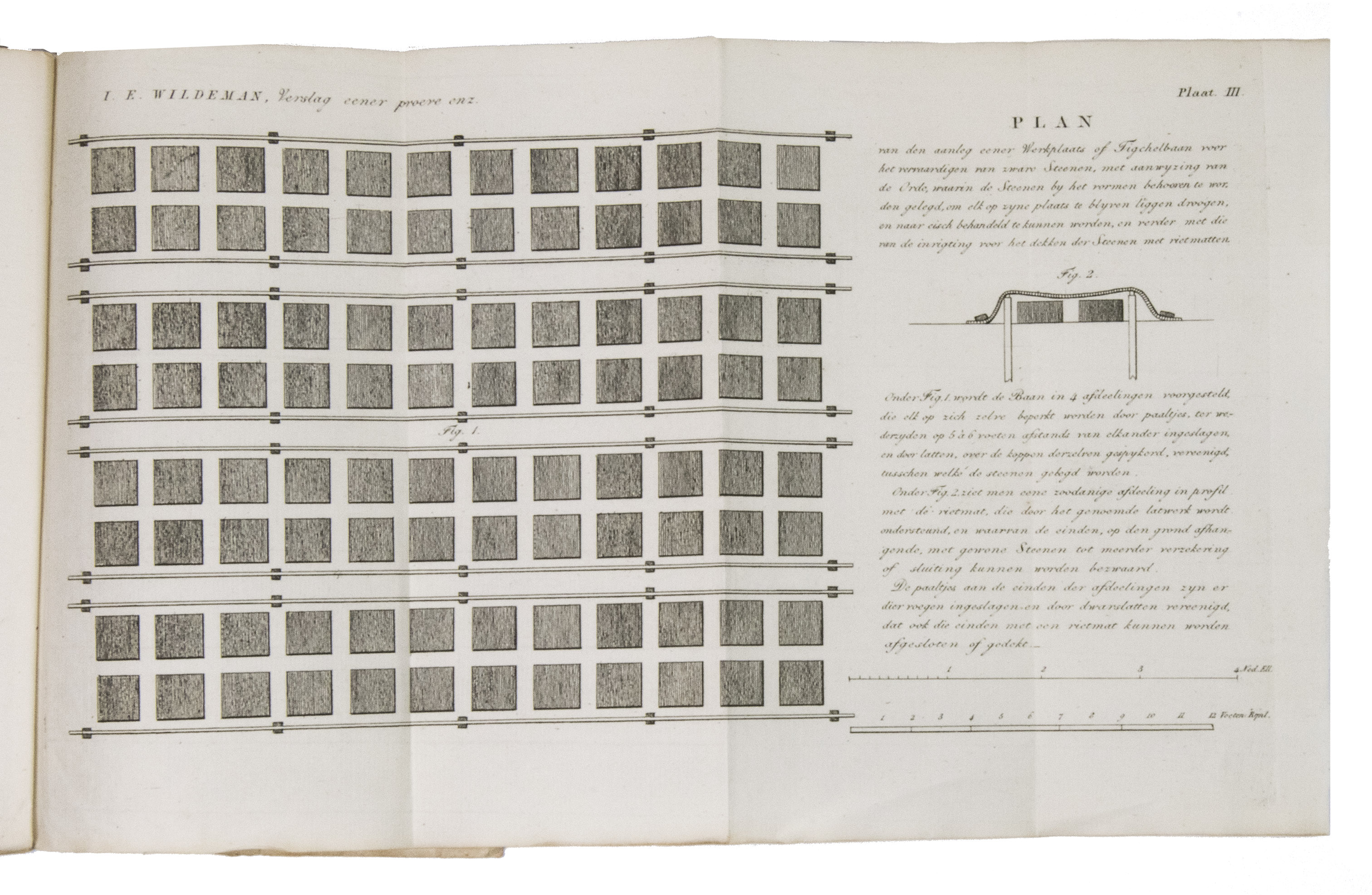
Author: WILDEMAN, Jan Ernst.
Title: Verslag eener proeve van het vormen, bakken en gebruiken van zware tigchelsteenen, voor het maken van steenglooijingen, of tot dekking der glooijingen van dijken.Amsterdam, Pieper en Ipenbuur, 1825. 8vo. With 3 large, folding engraved plates. Contemporary red sprinkled boards.
Description: 24 pp.Unusual publication about the use of tichelstenen (bricks) in stone batters to reinforce the Dutch dikes. The author, Jan Ernst Wildeman (1770-1833) started his career as an engineer in the Dutch army. After the Treaty of Amiens was signed (1802), he left the army and started working for the Directorate General for Public Works and Water Management (Rijkswaterstaat), and became head engineer for the bridges and roads along the IJssel River. It was in this position that he became interested in the reinforcement of dikes. At the time, stone from abroad was used for this goal. This was quite costly, and since the Netherlands were in the middle of an economic recession at the time, the dikes were somewhat neglected. In order to reduce the cost, Wildeman researched the options for using locally baked bricks. His ideas took hold and from 1811 onwards local bricks were used to strenghten various dikes across the country. In 1820, Wildeman wrote an article in which he explained how to produce and use these bricks. The article was published in the sixth edition (1823) of the periodical of the Koninklijk-Nederlandsche Instituut van Wetenschappen, Letteren en Schoone Kunsten (present day Royal Netherlands Academy of Arts and Sciences). It was then published separately a few years later as the present work. The three large, folding plates show how the bricks were laid out on the Bentdijk near Vollenhove, the very first dike they were used on in 1811.The spine and edges of the wrappers and edges of the leaves are slightly browned and frayed, some leaves are slightly creased. Otherwise in very good condition.l Verhandelingen der eerste klasse van het koninklijk-Nederlandsche instituut van wetenschappen, letterkunde en schoone kunsten, zesde deel, 1823, pp. 272-288; WorldCat 64783465 (7 copies); cf. Blok and Molhuysen, Nieuw Nederlandsch biografisch woordenboek, vol. 4 (about the author); Saakes 7, p. 462 (about the periodical).
Keywords: [L12BKU763RAL] LOW COUNTRIES|[L12BKU763RAL] LOW COUNTRIES -> [L12BR58IHOWV] Natural History & Science|[L12BKU763RAL] LOW COUNTRIES -> [L12BKU6WKUYS] Netherlands|[E51AD6E3D609] SCIENCE & TECHNOLOGY|[E51AD6E3D609] SCIENCE & TECHNOLOGY -> [82640FCA07D5] Tech
Title: Verslag eener proeve van het vormen, bakken en gebruiken van zware tigchelsteenen, voor het maken van steenglooijingen, of tot dekking der glooijingen van dijken.Amsterdam, Pieper en Ipenbuur, 1825. 8vo. With 3 large, folding engraved plates. Contemporary red sprinkled boards.
Description: 24 pp.Unusual publication about the use of tichelstenen (bricks) in stone batters to reinforce the Dutch dikes. The author, Jan Ernst Wildeman (1770-1833) started his career as an engineer in the Dutch army. After the Treaty of Amiens was signed (1802), he left the army and started working for the Directorate General for Public Works and Water Management (Rijkswaterstaat), and became head engineer for the bridges and roads along the IJssel River. It was in this position that he became interested in the reinforcement of dikes. At the time, stone from abroad was used for this goal. This was quite costly, and since the Netherlands were in the middle of an economic recession at the time, the dikes were somewhat neglected. In order to reduce the cost, Wildeman researched the options for using locally baked bricks. His ideas took hold and from 1811 onwards local bricks were used to strenghten various dikes across the country. In 1820, Wildeman wrote an article in which he explained how to produce and use these bricks. The article was published in the sixth edition (1823) of the periodical of the Koninklijk-Nederlandsche Instituut van Wetenschappen, Letteren en Schoone Kunsten (present day Royal Netherlands Academy of Arts and Sciences). It was then published separately a few years later as the present work. The three large, folding plates show how the bricks were laid out on the Bentdijk near Vollenhove, the very first dike they were used on in 1811.The spine and edges of the wrappers and edges of the leaves are slightly browned and frayed, some leaves are slightly creased. Otherwise in very good condition.l Verhandelingen der eerste klasse van het koninklijk-Nederlandsche instituut van wetenschappen, letterkunde en schoone kunsten, zesde deel, 1823, pp. 272-288; WorldCat 64783465 (7 copies); cf. Blok and Molhuysen, Nieuw Nederlandsch biografisch woordenboek, vol. 4 (about the author); Saakes 7, p. 462 (about the periodical).
Keywords: [L12BKU763RAL] LOW COUNTRIES|[L12BKU763RAL] LOW COUNTRIES -> [L12BR58IHOWV] Natural History & Science|[L12BKU763RAL] LOW COUNTRIES -> [L12BKU6WKUYS] Netherlands|[E51AD6E3D609] SCIENCE & TECHNOLOGY|[E51AD6E3D609] SCIENCE & TECHNOLOGY -> [82640FCA07D5] Tech
Price: EUR 850.00 = appr. US$ 923.82 Seller: A. Asher & Co. B.V.
- Book number: ABC_49314
- Book number: ABC_49314